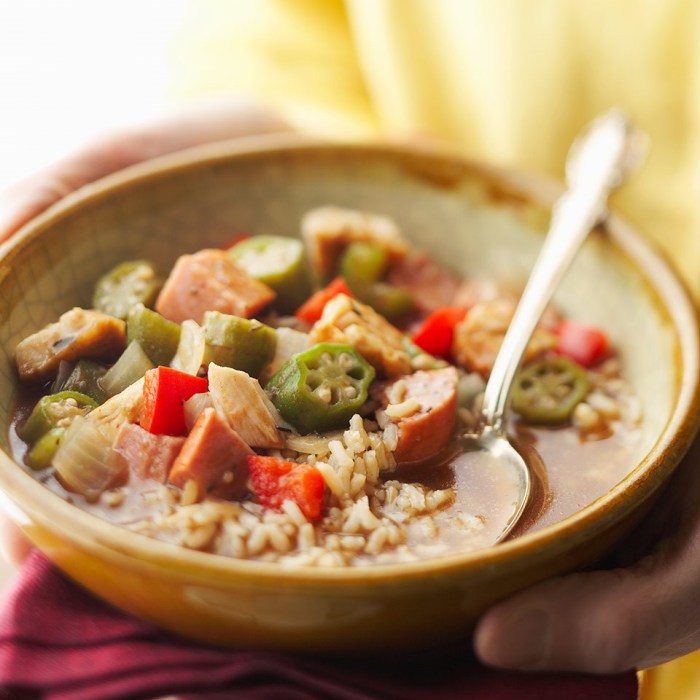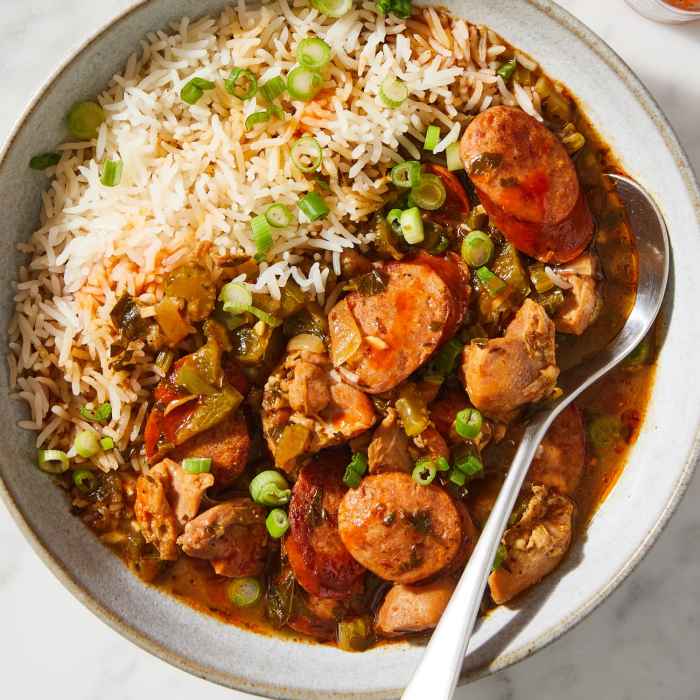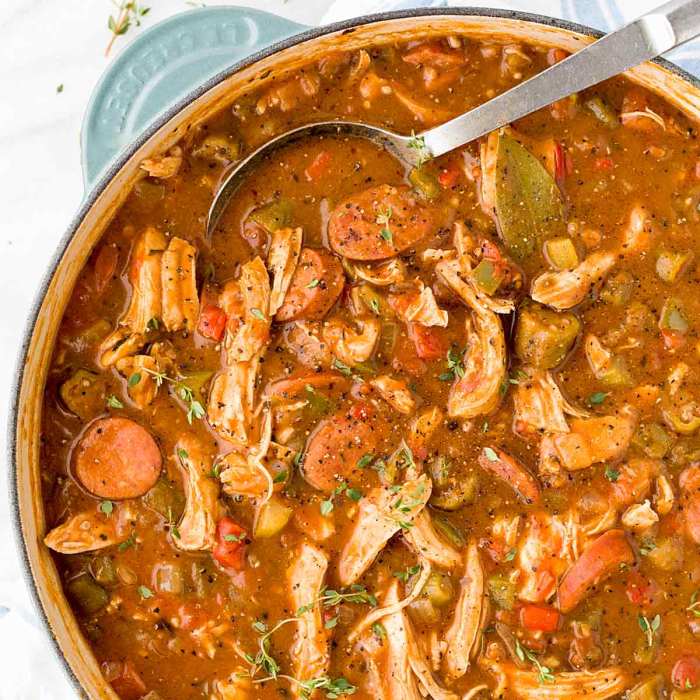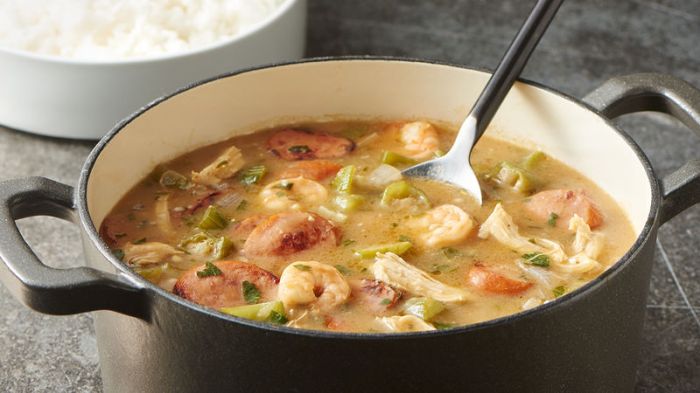Chicken and sausage gumbo recipe is a beloved dish deeply rooted in Louisiana’s culinary heritage. This hearty stew, brimming with rich flavors and textures, has become a staple across the region and beyond. Gumbo, with its origins tracing back to West African and French influences, embodies the spirit of Louisiana’s melting pot, where diverse cultures intertwine to create a unique and vibrant cuisine.
The heart of gumbo lies in its roux, a dark, flavorful base achieved by slowly cooking flour and oil until it reaches a desired shade. This roux, combined with the “holy trinity” of onions, celery, and bell peppers, forms the foundation for a symphony of flavors.
The addition of chicken and sausage, whether spicy Andouille or smoky links, adds a satisfying richness that complements the base. The result is a dish that warms the soul and transports you to the heart of Louisiana’s culinary tradition.
Chicken and Sausage Gumbo: A Taste of Louisiana
Chicken and sausage gumbo is a hearty and flavorful stew that is a staple of Louisiana cuisine. It’s a dish that embodies the rich cultural heritage of the state, a testament to its diverse culinary influences and a celebration of its unique flavors.
The History and Origins of Gumbo
Gumbo, in its various forms, has a rich history that stretches back centuries. The origins of the dish are believed to be rooted in West Africa, where a similar stew known as “gumbo” was made with okra, tomatoes, and meat.
When enslaved Africans were brought to the Americas, they brought their culinary traditions with them, including the preparation of gumbo.
- West African Influences:The word “gumbo” itself is believed to have originated from the Bantu word “ngombo,” which refers to okra. Okra, a key ingredient in many gumbo recipes, is thought to have been introduced to the Americas by West African slaves.
- French and Spanish Influences:The French and Spanish, who colonized Louisiana in the 18th century, also contributed to the development of gumbo. They introduced ingredients such as tomatoes, rice, and roux, a key element in many gumbo recipes.
- Native American Influences:Native Americans in Louisiana also played a role in shaping gumbo. They contributed ingredients such as filé powder, made from ground sassafras leaves, which adds a unique flavor and texture to the dish.
Ingredients
A hearty gumbo requires a blend of flavorful ingredients, each playing a crucial role in creating the signature taste of Louisiana cuisine. From the rich base of the roux to the protein sources and vegetables, every element contributes to the final dish.
The “Holy Trinity” of Gumbo
The “holy trinity” – onion, celery, and bell pepper – forms the foundation of the gumbo’s flavor profile. These vegetables are sautéed in the roux, releasing their aromas and creating a complex base for the gumbo.
- Onion:Adds a sweet and savory note to the gumbo, providing a subtle background flavor.
- Celery:Contributes a slightly bitter and earthy flavor, balancing the sweetness of the onion.
- Bell pepper:Adds a touch of sweetness and a vibrant color, enhancing the overall flavor profile.
Sausage Options
Gumbo is often enhanced with the addition of sausage, adding a smoky, spicy kick. Several types of sausage can be used, each contributing its unique flavor.
- Andouille:A spicy smoked sausage with a distinct Cajun flavor, it’s a classic choice for gumbo.
- Smoked sausage:Adds a smoky depth to the gumbo, providing a rich and savory flavor.
- Chorizo:A Spanish sausage with a spicy and savory flavor, it adds a unique twist to the gumbo.
Other Essential Ingredients
- Chicken:A traditional protein source for gumbo, chicken adds a delicate flavor and a tender texture.
- Roux:A mixture of fat and flour, roux is the base of the gumbo, providing a rich and thick consistency.
- Stock:Chicken or vegetable stock adds depth of flavor and helps to create a flavorful broth.
- Seasoning:Spices such as cayenne pepper, paprika, thyme, and bay leaves enhance the flavor of the gumbo.
- Okra:A traditional ingredient for gumbo, okra adds a slimy texture and a unique flavor.
- Rice:Served alongside the gumbo, rice absorbs the flavorful broth, creating a satisfying meal.
Techniques and Methods
The heart of a good gumbo lies in its roux, the foundation that provides its characteristic flavor and texture. Mastering the roux is essential for creating a delicious gumbo, while the browning of the chicken and sausage adds another layer of depth and richness.
Simmering the gumbo to achieve the perfect consistency completes the process, resulting in a satisfyingly thick and flavorful dish.
Preparing the Roux
The roux is a mixture of fat and flour cooked together until it reaches the desired color and texture. This process is crucial for developing the rich flavor of the gumbo.
- Start with a good fat:Choose a high-quality fat like bacon grease, vegetable oil, or butter. The type of fat will influence the flavor of the roux, so select one that complements the overall flavor profile of the gumbo.
- Gradually add the flour:Slowly whisk in the flour, ensuring it is thoroughly incorporated into the fat.
The flour will absorb the fat and start to cook, forming a paste.
- Cook the roux over low heat:Patience is key here. Cook the roux over low heat, constantly stirring, until it reaches the desired color. The color of the roux will determine the flavor of the gumbo.
- Monitor the color:The roux will progress through different stages, starting from a light blonde color and darkening to a deep brown. For a mild gumbo, aim for a light blonde roux. For a richer, darker gumbo, cook the roux until it reaches a deep brown color.
Check what professionals state about strawberry bread recipe and its benefits for the industry.
- Avoid burning the roux:Constant stirring is essential to prevent the roux from burning. Overcooked roux will have a bitter taste and should be discarded.
Browning the Chicken and Sausage
Browning the chicken and sausage adds another layer of flavor to the gumbo, enriching the overall taste profile.
- Season the chicken and sausage:Season the chicken and sausage with salt, pepper, and other desired spices. This will enhance their flavor and create a more flavorful gumbo.
- Brown the chicken and sausage in a separate pot:Brown the chicken and sausage in a separate pot over medium heat. This will allow them to develop a nice crust and release their natural flavors.
- Cook until golden brown:Brown the chicken and sausage until they are golden brown on all sides. This will ensure they are cooked through and have a delicious flavor.
- Remove from the pot and set aside:Once browned, remove the chicken and sausage from the pot and set aside.
They will be added to the gumbo later.
Simmering the Gumbo, Chicken and sausage gumbo recipe
Simmering the gumbo allows the flavors to meld and the roux to thicken, resulting in a rich and satisfying dish.
- Combine the ingredients:Combine the browned chicken and sausage, roux, vegetables, and broth in a large pot.
- Bring the gumbo to a simmer:Bring the gumbo to a simmer over medium heat. Simmering allows the flavors to meld and the roux to thicken.
- Reduce heat and simmer:Reduce the heat to low and simmer the gumbo for at least 30 minutes, or until the chicken is cooked through and the desired thickness is achieved.
- Adjust seasoning:Taste the gumbo and adjust the seasoning as needed. Add more salt, pepper, or other spices to enhance the flavor.
- Serve hot:Serve the gumbo hot with rice, a side of cornbread, or your favorite accompaniments.
Variations and Flavor Profiles

Chicken and sausage gumbo, like many traditional dishes, offers a canvas for culinary creativity. While the foundation remains the same, there’s ample room for personal preferences and regional variations to shine.
Seafood Gumbo
Seafood gumbo is a popular variation that introduces the bounty of the Gulf of Mexico to the gumbo pot. This version often includes shrimp, crab, and oysters, creating a symphony of flavors and textures. The addition of seafood imparts a delicate sweetness and a briny note that complements the rich roux and savory sausage.
Vegetarian Gumbo
For those seeking a meat-free option, vegetarian gumbo is a delicious alternative. This version swaps out the sausage for hearty vegetables like mushrooms, eggplant, or okra. The use of vegetable broth and a generous amount of spices helps create a flavorful and satisfying meal.
Customizing Spice Level and Flavor Profile
The beauty of gumbo lies in its adaptability. You can tailor the spice level and flavor profile to your liking. For a milder gumbo, use less cayenne pepper or omit it altogether. To enhance the heat, add a pinch of hot sauce or a sprinkle of red pepper flakes.
Tip:Start with a moderate amount of spices and adjust to your taste preference. Remember, you can always add more, but you can’t take it away.
You can also experiment with different herbs and spices to create unique flavor profiles. For example, a touch of thyme or oregano adds a Mediterranean flair, while a pinch of smoked paprika imparts a smoky depth.
Comparing Different Gumbo Types
| Gumbo Type | Unique Characteristics ||—|—|| Chicken and Sausage Gumbo | Classic, hearty, and savory. Features chicken, sausage, and a rich roux. || Seafood Gumbo | Delicate and briny. Includes shrimp, crab, and oysters. || Vegetarian Gumbo | Flavorful and satisfying.
Replaces sausage with hearty vegetables. |
Serving and Accompaniments

Gumbo, a hearty and flavorful Louisiana staple, is best enjoyed hot and served with traditional accompaniments that complement its rich flavors.
Serving Temperature
Gumbo should be served piping hot, allowing the flavors to fully develop and the ingredients to meld together. Ideally, it should be served at a temperature of 160-170°F (71-77°C). This ensures a satisfyingly warm and comforting meal.
Traditional Accompaniments
The ideal accompaniments for gumbo enhance its flavors and provide textural contrast.
- Rice:White rice is the classic accompaniment for gumbo, absorbing the flavorful broth and providing a neutral base for the rich flavors.
- Cornbread:A slice of warm, buttery cornbread offers a contrasting sweetness and crumbly texture that complements the gumbo’s savory notes.
- Green Onions:Fresh green onions, chopped and sprinkled on top, add a vibrant touch of freshness and a subtle onion flavor that balances the richness of the gumbo.
Wine Pairings
The robust flavors of gumbo pair well with a variety of wines.
- Chardonnay:A crisp, oaky Chardonnay complements the richness of the gumbo, while its acidity cuts through the heaviness of the dish.
- Zinfandel:A fruity Zinfandel, with its bold flavors and high alcohol content, can stand up to the spicy and savory flavors of gumbo.
- Pinot Noir:A lighter-bodied Pinot Noir, with its earthy and fruity notes, can also pair well with gumbo, particularly those with a seafood base.
Tips and Tricks

Gumbo, with its rich history and diverse flavors, is a dish that rewards patience and attention to detail. However, even experienced cooks can encounter challenges along the way. Here are some helpful tips and tricks to ensure your gumbo turns out perfectly every time.
Adjusting Gumbo Consistency
Gumbo consistency is a matter of personal preference. Some prefer a thick, hearty gumbo that coats the spoon, while others enjoy a thinner, more soup-like version. To achieve the desired consistency, follow these guidelines:
- For a thicker gumbo:If your gumbo is too thin, you can thicken it by adding a roux, okra, or a cornstarch slurry.
- For a thinner gumbo:If your gumbo is too thick, you can thin it out by adding more broth or water.
Making Gumbo Ahead of Time
Gumbo is a dish that benefits from being made ahead of time, as the flavors have time to meld and deepen. You can make gumbo up to 3 days in advance and reheat it before serving.
- Storing gumbo:Store your gumbo in an airtight container in the refrigerator for up to 3 days.
- Reheating gumbo:When reheating gumbo, gently simmer it on the stovetop or in the oven. Avoid boiling, as this can cause the gumbo to become watery.
Storing Leftover Gumbo
Leftover gumbo can be stored in the refrigerator for up to 3 days. To prevent spoilage, follow these steps:
- Store in airtight containers:This will help to prevent the gumbo from absorbing odors from other foods in the refrigerator.
- Label and date the container:This will help you keep track of how long the gumbo has been stored.
Ultimate Conclusion: Chicken And Sausage Gumbo Recipe

Whether you’re a seasoned gumbo aficionado or a curious newcomer, exploring the world of chicken and sausage gumbo is an adventure for the senses. From the captivating history to the diverse variations and techniques, there’s a lot to discover in this culinary treasure.
So, gather your ingredients, embrace the process, and prepare to be transported to the heart of Louisiana with every spoonful of this flavorful and satisfying dish.
